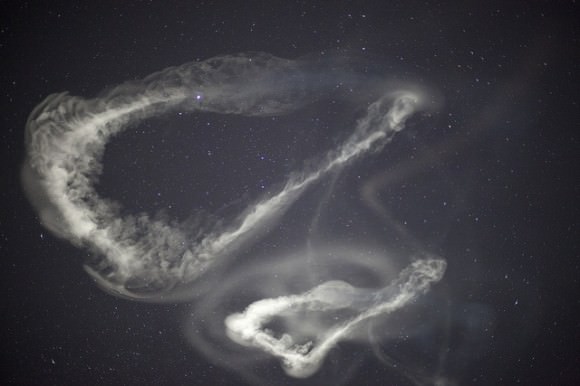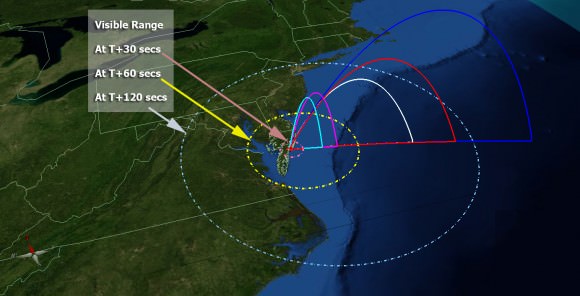Martian Dust Devils & The Shuttles | SciByte 43
Posted on: April 24, 2012

We take a look at aurora on Uranus, Martian dust devils, counting penguins, Apollo 8 images, the high altitude jet stream, the latest on the shuttles, and as always take a peek back into history and up in the sky this week.
Direct Download:
MP3 Download | Ogg Download | HD Video | Mobile Video | YouTube
RSS Feeds:
MP3 Feed | Ogg Feed | iTunes Feed | HD Feed | Mobile Feed
Support the Show:
|
Show Notes:
Uranus Aurora

Credit: Laurent Lamy
- The low down
- Unlike the other planets Uranus has a bizarre 98-degree tilt relative to the solar system’s orbital plane and its magnetic axis is 60 degrees off from that
- This unusual configuration makes the planet appear to roll around on its side as it orbits the sun every 84 years
- When magnetic field lines converge, at a planet’s poles, they funnel incoming charged solar particles into the planet’s atmosphere
- When those particles collide with air molecules, making the molecules glow producing Aurora
- Now an international team of astronomers have used the Hubble Space Telescope to capture the first aurora seen on Uranus from Earth
- Significance
- Scientists first observed the planet’s auroras only once, during a Voyager flyby in 1986 on the night side of the planet
- There the probe’s instruments had a much better view of the glows, which lasted longer, covered a larger area, and covered the unlit side of Uranus
- Scientists unsuccessfully tried to again detect this phenomenon in 1998 and 2005 from the Earth
- The new observations of the Aurora seemed to indicate they lasted for only a couple of minutes
- Different planetary arrangements could explain the significant differences in the two observations
- In 1986 planet’s rotational axis was pointed almost directly at the sun, whereas in in 2011 the axis lay almost perpendicular to the flow of solar wind
- When the team learned of an impending solar storm directed toward Uranus, timed their Hubble observations specifically to coincide with the solar storm
- The storm would hit 3 months after the strong gust in the solar wind raced past Earth on its way to Uranus
- In November 2011 researchers caught their first glimpse of the brief auroras from our planet’s neighborhood six weeks later
- This new observational data should help scientists better understand Uranus odd magnetic field
- Of Note
- Further investigations into Uranus’ auroras and magnetic field could provide insight into Earth’s own magnetosphere and how it interacts with the solar wind
- This information will become invaluable with our ever increasing technological society
- Multimedia
- Further Reading / In the News
- Uranus auroras glimpsed from Earth | agu.org
- Rare Photo: Auroras on Uranus Spotted by Hubble Telescope | livescience.com
- Hubble Reveals Curious Auroras on Uranus | universetoday.com
- Auroras Seen on Uranus For First Time | nationalgeographic.com
- ScienceShot: Hubble Spots Auroras on Uranus | news.sciencemag.org
*— NEWS BYTE — *
Martian Dust Devils
 Credit: MSSS / JPL / NASA
Credit: MSSS / JPL / NASA
- Last time on SciByte
- Thanks Angela for pointing this out
- The low down
- Unlike a tornado, a dust devil typically forms on a clear day
- The ground is heated by the sun, warming the air just above the ground, heated air near the surface rises quickly through a small pocket of cooler air above it and the air may begin to rotate, if conditions are just right.
- The Mars Reconnaissance Orbiter has been examining Mars with six science instruments since 2006
- Mars orbiters, rovers and landers have all captured devils in action before
- Significance
- Typical tornadoes on Earth are less than 10 miles tall, while dust devils on our planet seldom reach more than 300–900 feet [100–300 yards]
- The Feb 16 dust devil lofted a twisting column of dust more than half a mile [800 meters] high, and had approximately a 90 ft [30 yards] radius
- The March 14 dust devil stretched 12 miles [20 kilometers] up from the planet’s surface and had a 230 ft [70 m]
- The mass of an dust devil column on Mars is less than 1 percent than that of one on Earth, allowing their incredible heights on Mars
- In addition more thermal convection from the surface make makes if possible for the dust devils to go higher into the atmosphere of Mars then they do here on Earth
- Of Note
- Although you would be blasted by sand and dust these dust devils are unlikely to knock you over because of the low density of the Martian atmosphere
- This mission has returned more data about Mars than all other orbital and surface missions combined and can reveal features as small as a desk
- More than 21,700 images taken by HiRISE are available for viewing on the instrument team’s website
- Multimedia
- Social Media
- HiRISE @HiRISE
- Further Reading / In the News
- A Monster Dust Devil Stalks the Martian Landscape | uahirise.org
- New Gigantic Tornado Spotted on Mars | universetoday.com
- The Serpent Dust Devil of Mars | uahirise.org
- Huge Dust Devil on Mars Captured in Action @ UniverseToday.com
- Mars orbiter catches twister in action @ PhysOrg.com
- Photo from NASA Mars orbiter shows wind’s handiwork (Jan 2012) @ PhysOrg.com
Studying the high-altitude jet stream


Credit: NASA Wallops
- The low down
- After several days of delays due to the weather NASA launched the 5 ATREX rockets within 5 min of each other on March 27
- Each of the rockets released a chemical tracer that was used to get more data of the high-altitude jet stream located 60–65 mi [95–105 km]
- Two of the rockets also contained instruments to measure temperature and pressure
- Hopefully this data will help us to better understand the processes behind this jet stream
- Significance
- The high-altitude jet stream that this project was looking at is much higher than the one in the nightly weather report
- The upper jet-stream typically has winds of about 200–300 mph [320–480 km/hr] and is a region of electrical turbulence that can affect satellites and radio
- Of Note
- NASA will release more information about the outcome of the mission after scientists have had time to review the data
- Multimedia
- Further Reading / In the News
*— TWO-BYTE NEWS — *
Counting Penguins from space

Credit: (left) DigitalGlobe; (right) British Antarctic Survey
- The low down
- A simple snap of a photograph of a penguin colony, and some marking can help scientist accurately count the number of penguins in a colony
- Those numbers are hard to get however in remote places, especially in the Antarctic
- A new technique uses satellite imaging to report results
- Of Note
- Scientists have now found twice as many Emperor penguins than thought to exist
- This brings the total colonies to 44 (7 new ones) and ~595,000 (+/- 81,000)
- Further Reading / In the News
The view from Apollo 8
- The low down
- December 24, 1968, Apollo 8 : Commander Frank Borman and crew members William A. Anders and James A. Lovell, Jr. became the first humans to photograph the Earth rising over the moon.
- This video recreates what they saw, and interweaves the photographs they took and hear the original audio recording
- Multimedia
Asteroid Lutetia Flyby
- The low down
- Images from ESA’s robotic Rosetta spacecraft were compiled to make a video of the bly-by it made
- The mission was focused on determining the origins of the asteroid and it’s unusual colors by taking data and images
- Multimedia
SPACECRAFT UPDATE
The Shuttle Shuffle

Credit: Ken Kremer
- Multimedia / Further Reading
- YouTube : Discovery’s Journey Playlist | NASA
- Welcome, Discovery! | Smithsonian National Air and Space Museum
- Space Shuttle Discovery Buzzes D.C. Monuments (Pictures) | news.nationalgeographic.com
- Discovery & Enterprise – Historic Nose to Nose Shuttle Image | universetoday.com
- Photos: Space Shuttle Discovery’s Final Voyage (to Museum) | space.com
- Shuttle Discovery Flies Over Washington D.C. to New Home | universetoday.com
- Discovery Does Dulles & DC | universetoday.com
- Gallery: Discovery Leaves Kennedy Space Center for the Final Time | universetoday.com/
- flickr |Space Shuttle Discovery | flickr.com
- Discovery Poised for Final Takeoff on April 17 | universetoday.com
- Discovery Enters Eternal Smithsonian Home as Historic Relic | universetoday.com
- Space Shuttle Discovery Enters Smithsonian for Museum Display | space.com
- Managers Defer Ferry Flight Decision until Monday | NASA.gov
Private deliveries to the Space Station
- The historic flight of the first commercial transport to the International Space Station, The Dragon, now has a launch date of around May 7.
SCIENCE CALENDER
Looking back
- April 25, 1990 : 22 years ago : Hubble Space Telescope Deployed : In 1990, the $2.5 billion Hubble Space Telescope was deployed in space from the Space Shuttle Discovery into an orbit 381 miles above Earth. It was the first major orbiting observatory, named in honour of American astronomer, Edwin Powell Hubble. It was seven years behind schedule and nearly $2 billion over budget. In orbit, the 94.5-in primary mirror was found to be flawed, giving blurred images and reduced ability to see distant stars. However, correcting optics were successfully installed in 25 Dec 1993. The telescope 43-ft x 14-ft telescope now provides images with a clarity otherwise impossible due to the effect of the earth’s atmosphere. Instrument packages capture across the electromagnetic spectrum.
Looking up this week
-
Keep an eye out for …
-
Wed, April 25 : Orion is to the lower left of the Moon
-
Sat, April 28 : Mars and Regulus are in the South and Saturn and Spica are in the SE with about 5* between the pairs (three fingers at arms length)
-
April 28 – Mar 01 : Venus is high in the W just after sunset, setting around 11
-
Mars is high in the S at dusk
-
Jupiter is low in the W in the sunset, far below Venus
-
Saturn is low in the SE peaking in height around midnight
-
The southern hemisphere should, Keep an eye out for …
-
Wed, April 25 : Orion is the ot upper left of the moon and Venus
-
Further Reading and Resources
-
More on what’s in the sky this week
-
Constellations of the Southern Hemisphere : astronomyonline.org






 del.icio.us
del.icio.us blinklist
blinklist digg
digg Facebook
Facebook Furl
Furl ma.gnolia
ma.gnolia Newsvine
Newsvine Pownce
Pownce reddit
reddit StumbleUpon
StumbleUpon Technorati
Technorati Twitter
Twitter